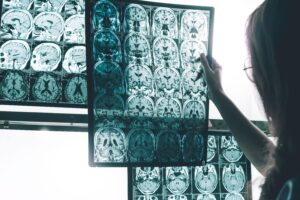A common approach to model Parkinson’s disease (PD) in rodents involves the use of neurotoxins such as rotenone, a mitochondrial complex I inhibitor. Systemic rotenone administrations in mice cause a rapid induction of PD symptoms. However, results are often characterized by a high variation and thus lack robustness.
Unilateral injection of rotenone into the caudate putamen (CPu) therefore provides a good alternative to previous approaches. Injections lead to a reduced motor performance in several behavioral tests but also to a disturbed dopaminergic signalling, increased neurodegeneration, as well as neuroinflammation indicated by activated microglia and astrocytosis.
In detail, mice were tested in two motor behavioral tests at three time points: before (baseline) and 2 and 4 weeks after unilateral rotenone injection. Rotenone-injected animals showed a significantly impaired motor performance after 4 weeks in the rotation test (Figure 1A) and already after 2 weeks in the beam walk test compared to mice injected with DMSO (Figure 1B).

Figure 1. Motor deficits in rotenone-injected mice. A: Percent of ipsilateral rotations in the rotation test and B: Slips per steps in the beam walk test before (baseline) and 2 and 4 weeks after rotenone or DMSO injection. Mean + SEM (n=16-28 per group). Two-way repeated mixed-model ANOVA followed by Bonferroni post hoc test, comparing groups at each timepoint and timepoints within each group. **p <0.01, ***p<0.001, #p <0.05, ###p <0.001.
Further analyses showed that rotenone injection caused a reduction of tyrosine hydroxylase (TH) levels in the injected CPu while TH levels stay physiological in the contralateral CPu (Figure 2A). Measurement of neurofilament light chain (NFL) levels in terminal plasma samples showed that NFL levels are significantly increased in rotenone-injected mice already 2 weeks after injection. Four weeks after rotenone injection, NFL levels were still significantly increased compared to DMSO-injected mice, but levels decreased compared to plasma collected 2 weeks after rotenone injection (Figure 2B).
Histological evaluations of phosphorylated α-synuclein levels resulted in significantly increased α-synuclein levels phosphorylated at residue Ser129 (pSer129-α-syn) in the CPu of the rotenone-injected hemisphere (Figure 2C). Analysis of the neuroinflammation markers Iba1 for activated microglia (data not shown) and GFAP for astrocytosis resulted in significantly increased immunoreactive areas in the CPu injected with rotenone compared to the contralateral CPu already 2 weeks after injection (data not shown). Similar results were observed in the substantia nigra. Levels of both markers stayed increased 4 weeks after injection as shown for GFAP in Figure 2D.

Figure 2. Neuronal pathology of rotenone-injected mice. A: Tyrosine hydroxylase (TH) levels as area under the curve (AUC) in the ipsi- and contralateral CPu of rotenone- and DMSO-injected mice at baseline and 2 and 4 weeks after injection; n = 8. B: Neurofilament light chain (NFL) levels in pg/ml plasma in terminal plasma collected from rotenone- and DMSO-injected mice at baseline and 2 and 4 weeks after injection; n = 8-10. C: pSer129- α-synuclein and D: Glial fibrillary acidic protein (GFAP) immunoreactive (IR) area in percent in the ipsi- and contralateral substantia nigra of rotenone- and DMSO-injected mice at baseline and 2 and 4 weeks after injection; n = 8. Mean + SEM. A, C and D: Two-way repeated ANOVA followed by Bonferroni post hoc test: *differences between contra and ipsilateral hemispheres within the same animal; #differences between treatment groups when comparing the same hemisphere. B: One-way ANOVA followed by Bonferroni post hoc test to compare all groups against baseline, and two-way ANOVA followed by Bonferroni post hoc test (baseline values were excluded) to evaluate differences across groups and time points. *differences between groups across time points, #differences to baseline. */#p<0.05, **/##p<0.01 ***/###p<0.001. C/contra, contralateral; I/ipsi, ipsilateral.
It can be summarized that unilateral injection of rotenone into the caudate putamen of wild type mice results in strong motor deficits, a disturbed dopamine signalling, neurodegeneration and neuroinflammation. Effects are robust and mostly observed in the injected brain region but additionally in the ipsilateral substantia nigra, while contralateral brain regions to the rotenone-injected hemisphere are not affected. As pathologies are already obvious 2 to 4 weeks after rotenone injection, rotenone-injected mice display a very fast PD model and thus allow testing of your PD drug with a very short lead time.
Contact us today to get your study in this intracerebrally-injected rotenone mouse model started!









